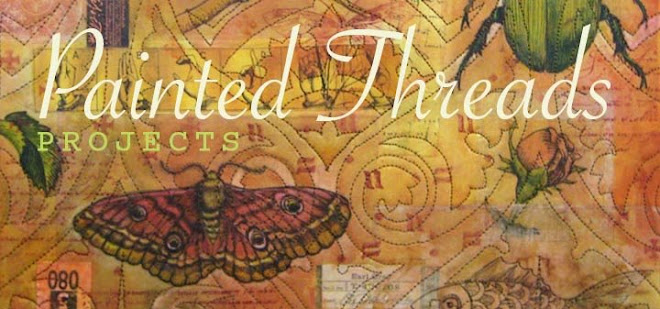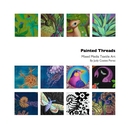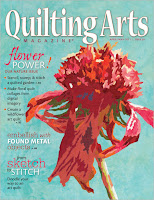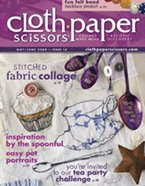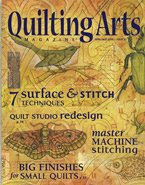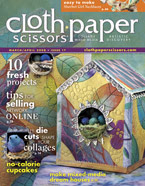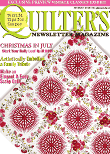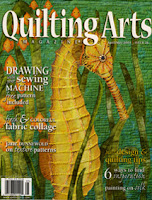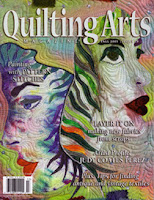I love getting really focused and tightly
rendering a representational image while painting, but recently I have been trying to get looser and more gestural with my painting, kind of like the direction I take with some of my
mixed media work, but pushing it even further. For my latest quilt, which represents my present emotional state of mind, I tried to work more spontaneously without pre-planned imagery.

After experimenting with
Daler Rowney FW Acrylic Inks, I decided to use them for painting a 4' x 5' piece of cotton sheeting with large loose brush strokes of random color, to see how the inks would work covering large areas and what would happen as the different colors overlapped.
I really liked how the colors would get soft and mottled if the fabric was very wet with ink
and if the fabric was dry, there would be visible brush strokes
After painting the fabric, I used a permanent marker to write personal words and phrases that expressed some of my feelings. These messages are being written for my own catharsis and ultimately will not be very legible to the viewer. My intention is for the words to be embedded in the work like a talisman.
I also collaged a few bits of printed imagery; a toner printed tea bag and some painted abaca paper that I had leftover from making my
One collages.
I also used some of my hand carved stamps with the ink and it worked great, not as thick and gloppy as stamping with regular acrylics.
My next step was to draw/paint some big floral imagery. To draw the flower motifs, I thought I would try this
solid stick permanent marker I ordered from Dharma.
It was kind of a creamy consistency, much like an oil pastel. It had a little bit of odor but as it dried (after a couple hours) the smell went away. It was easy to draw on the fabric and quickly work out a design. I used the whole stick to draw the images on the quilt, it was easy and convenient but did not go very far.
I am not sure it was better than using a paint brush and paint, but it was probably faster. If you are more comfortable drawing than painting a design freehand then I would recommend it.
To define the flowers from the background it was a matter of painting different colors of ink over the separate areas. For example I painted yellow over the blue areas of the leaves and blue over yellows to get an overall green. I painted a deeper blue over the areas that would be background, making it overall blue yet with all kinds of variations in hue because the colors underneath effect it in different ways.
The large flower was painted over with white, since there was so much green in the under painting it would have been difficult to put a warm color over it without getting a muddy dark flower. As I painted the flowers and background I ended up using white textile paint to add more details and painting over some of the drawn lines to make them bolder.
The next part of the design process involved creating a layer of thorny black weeds to paint on top of the floral imagery.
I took a photo of the painted fabric (by putting it on the floor and standing on a table) and printed out a copy on 8 1/2" x 11" paper. I placed tracing paper over the top and drew multiple versions of weeds until I had it the way I wanted and made a final clean copy with black marker.
My next problem was to figure out how to transfer my design to the painted fabric. I decided the best way to do it would be to project the image on to the cloth. Not having an overhead projector, I decided to use my digital projector that I use for giving lectures.
I scanned the tracing paper and opened the jpg in photosshop, connected my laptop to the projector, taped my painted cloth to the wall and lined up the projected line drawing over the painting. I used a fine point sharpie to trace the line drawing onto my painting.
I painted the weeds with black textile paint, since I wanted it to have the most opacity and I knew it would be tough to cover the white lines.
So now you see where I am, one year after the Three of Swords quilt. There has been some difficult and ugly stuff (represented by thorny weeds) that I have had to deal with, but in the
space between there has been a lot of growth, blossoming, renewal, light and life. Even the black bitterness has it's own beauty, it's just a little hard to see sometimes :-) So in other words, I am good! and life is certainly interesting, lol.
Basting
When I prepare a whole cloth painting for quilting my secret weapon is
Mistyfuse. I am not fond of basting and when I discovered Mistyfuse could replace hours of tedious basting with fantastic results, I never looked back. I love this product and never make a quilt without it anymore.
I place my painted fabric face down on a surface I can iron on. For that I have a large plywood board wrapped with batting and muslin that I put on top of my work table. Then I cover the back of the fabric with a layer of Mistyfuse.
That roll is a bolt of mistyfuse.
Mistyfuse is as light as a spider web with delicate little strands of fusible adhesive, which will not change the hand of the fabric at all.
I lay a large silicon pressing sheet or parchment paper over the top and iron at the hottest setting.
After the whole back is covered with Mistyfuse, I put a bed sheet on the floor and spread the wool batting out on top. Next, I put the quilt top on with the Mistyfuse side down on the batting. Starting in the center of the fabric and working my way concentrically outward, I iron it on the hottest setting, fusing the top to the batting.
Then I turn the whole thing over, with the painted fabric face down on the sheet. I cut one to two inch squares of Mistyfuse and place them in a loose grid approximately 6 to 8 inches apart across the batting. I carefully lay the backing fabric over the top and iron the surface, which effectively spot fuses the back fabric to the batting.
Freemotion Quilting
I begin the process of freemotion machine quilting, by anchoring the quilt by outlining various parts of the quilt with stitching. This helps to stabilize the quilt. On this particular quilt I stitched around all the wed shapes with black thread and all the flowers with white thread. Then I worked on filling in those areas with different quilting designs.
When the quilting is finished, I block the quilt by pinning it to the carpet and steaming it. This smooths it out, puffs up the batting and makes the quilt lay flat.
Next it's important to make sure the quilt is square by using large straight edges and triangles to check all the corners.
I use a Bohin chalk pencil to mark the finished size of the quilt for cutting.
Then I trim the excess quilted fabric away, using a rotary cutter and butting up several large cutting mats, leaving an extra 1/4 inch seam allowance all the way around to sew the binding to.
I prefer a
faced binding which is not visible from the front the quilt, giving it a nice clean finished edge.
 |
| Black and Bloom All Over Judy Coates Perez 36" x 48" |
